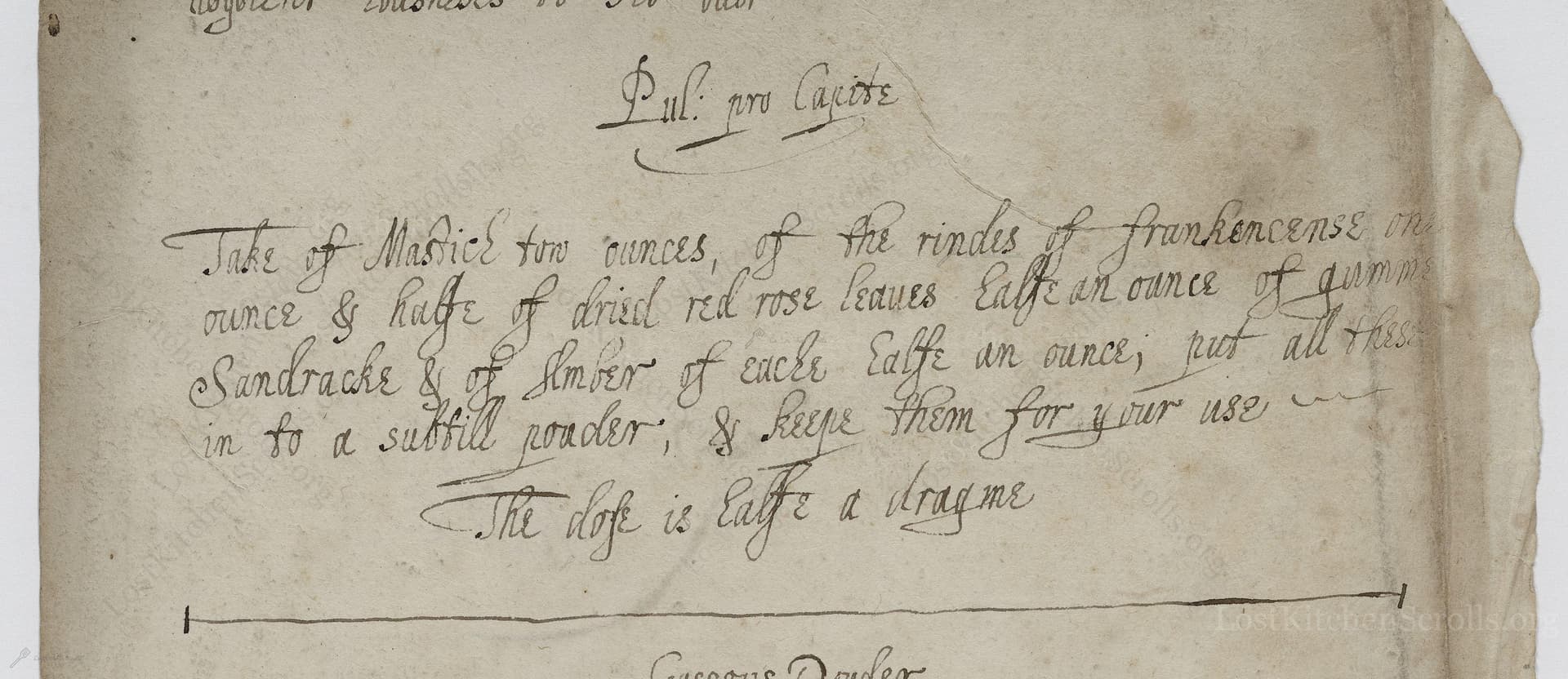Pul: Pro Capite
From the treasured pages of Receipt book of Rebeckah Winche
Written by Rebecca Winch

Pul: Pro Capite
"Take of Mastick two ounces, of the rindes of frankencense one ounce, & halfe of dried red rose leaves Ealfe an ounce, of gumme Sandracke & of Amber of each Ealfe an ounce, put all these in to a subtill powder, & keepe them for your use. The dose is halfe a dragme"
Note on the Original Text
This recipe is written in the concise, list-driven style typical of 17th-century English household manuscripts. Ingredient names and measures reflect the period's Latin influence ('pro Capite' meaning 'for the head'). Measures like 'ounce' and 'drachm' were standard, but their exact equivalents varied; here, a drachm is approximately 3.9 grams, but the recipe uses half a drachm per dose. Spelling differences—such as 'gumme Sandracke' for sandarac—are characteristic of early modern orthography before English spelling was standardized.

Title
Receipt book of Rebeckah Winche (1666)
You can also click the book image above to peruse the original tome
Writer
Rebecca Winch
Era
1666
Publisher
Unknown
Background
Step into the 17th-century kitchen with Rebecca Winch, where hearty feasts and time-honored recipes whisper secrets of early English cooking. From savory pies to delicate sweets, this charming volume offers a sumptuous glimpse into culinary history.
Kindly made available by
Folger Shakespeare Library
This aromatic powdered mixture, 'Pul: pro Capite:' appears in a mid-17th century English collection from Rebecca Winch, around 1666. Recipes of this type were part of early modern household medicine, intended for health and wellness more than for dining pleasure. Ingredients like mastic, frankincense, and amber were prized for their aromatic and supposed restorative properties, believed to strengthen the head (the 'capite' of the recipe's title refers to the head). Such recipes ran on the edge between culinary and apothecary arts, with the domestic (often female) healer at the center of household care.

Historically, this recipe would have been prepared with a mortar and pestle for fine grinding, and possibly a small sieve for sifting the powder. The finished powder would be kept in a glass or stoneware jar—with a tightly fitting lid to preserve its potency. The precise measurement of a drachm was achieved using handheld apothecary scales, a standard tool in well-appointed 17th-century kitchens and still rooms.
Prep Time
15 mins
Cook Time
0 mins
Servings
56
We've done our best to adapt this historical recipe for modern kitchens, but some details may still need refinement. We warmly welcome feedback from fellow cooks and culinary historians — your insights support the entire community!
Ingredients
- Mastic resin - 2 oz
- Frankincense resin (rind) - 1 oz (substitute with pure frankincense if rind unavailable)
- Dried red rose petals - 0.5 oz
- Gum sandarac - 0.5 oz (can substitute with a small amount of pine resin if original is unavailable, but sandarac can be sourced online)
- Amber - 0.5 oz (substitute with a tiny amount of amber powder or omit, as ingestible amber is rare; consult a specialist if considering a substitute)
Instructions
- To recreate 'Pul: pro Capite:', begin by gathering modern equivalents of the historical ingredients.
- Measure out 2 ounces of mastic, 1 ounce of powdered frankincense resin (rinds), 0.5 ounces of dried red rose petals, 0.5 ounces each of gum sandarac and amber (or a safe resin substitute).
- Grind all the ingredients together into a fine, homogenous powder using a mortar and pestle or a spice grinder.
- Store the powder in an airtight container until needed.
- The recommended serving dose is about 0.07 ounces (half a drachm).
Estimated Calories
6 per serving
Cooking Estimates
Preparing this recipe takes a short time because all you need to do is gather the ingredients, grind them together, and store the powder. Each serving is small and meant to be used as a powder.
As noted above, we have made our best effort to translate and adapt this historical recipe for modern kitchens, taking into account ingredients nowadays, cooking techniques, measurements, and so on. However, historical recipes often contain assumptions that require interpretation.
We'd love for anyone to help improve these adaptations. Community contributions are highly welcome. If you have suggestions, corrections, or cooking tips based on your experience with this recipe, please share them below.
Join the Discussion
Rate This Recipe
Dietary Preference
Main Ingredients
Culinary Technique
Occasions

Den Bockfisch In Einer Fleisch Suppen Zu Kochen
This recipe hails from a German manuscript cookbook compiled in 1696, a time whe...

Die Grieß Nudlen Zumachen
This recipe comes from a rather mysterious manuscript cookbook, penned anonymous...

Ein Boudain
This recipe comes from an anonymous German-language manuscript cookbook from 169...

Ein Gesaltzen Citroni
This recipe, dating from 1696, comes from an extensive anonymous German cookbook...
Browse our complete collection of time-honored recipes



